Happy Christmas
This Christmas, Cruise the Nile! Book Now & make your Egyptian Holiday Unforgettable!
Happy Christmas
This Christmas, Cruise the Nile! Book Now & make your Egyptian Holiday Unforgettable!
This Christmas, Cruise the Nile! Book Now & make your Egyptian Holiday Unforgettable!
This Christmas, Cruise the Nile! Book Now & make your Egyptian Holiday Unforgettable!
St, 152, number 10, Maadi, Cairo, Egypt.
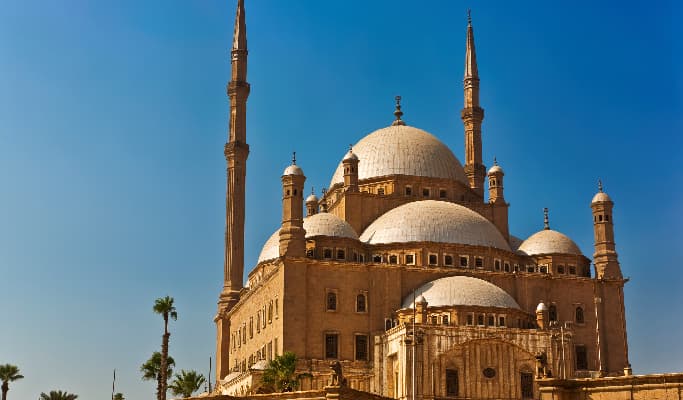
The Mosque of Mohamed Ali, built in the 19th century by Muhammad Ali Pasha, is one of Egypt’s most iconic landmarks. Located in the Citadel, it stands out for its Ottoman style, alabaster walls, tall minarets, and panoramic views, making it a must-visit for history and architecture lovers. This guide covers its history, architecture, link to Islamic Cairo, and visitor tips.
The Mosque of Muhammad Ali was commissioned in the early 19th century by Muhammad Ali Pasha, the Ottoman Albanian commander who rose to power in 1805 and is often regarded as the founder of modern Egypt. Seeking to assert his independence from the Ottoman Empire and transform Cairo into the heart of his envisioned dynasty, he ordered the mosque’s construction atop the historic Citadel, a symbol of authority since the time of Salah al-Din. Built between 1830 and 1848, the mosque adopted an Ottoman Baroque style inspired by Istanbul’s Sultan Ahmed Mosque, marking a clear departure from Cairo’s traditional Mamluk designs. To prepare the elevated site, ruined Mamluk palaces were demolished and the ground was filled with rubble to create a stable foundation. Visible across much of Cairo, the mosque not only served as a place of worship but also as a powerful statement of Muhammad Ali’s political ambitions, his modernization efforts, and his vision of Egypt as a rising force in the region.
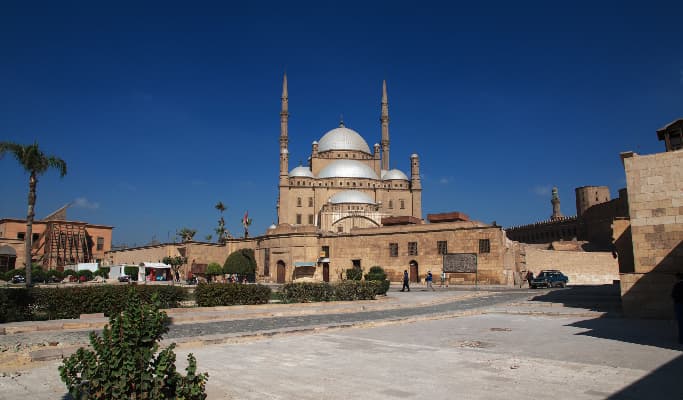
The Mosque of Mohamed Ali is one of Cairo’s greatest architectural treasures, renowned for its elegance, size, and stylistic uniqueness. Unlike the traditional mosques of Cairo that followed the Mamluk and Fatimid traditions, Muhammad Ali’s mosque introduced a pure Ottoman Baroque style to the city. Designed by Yusuf Boşnak, the layout closely mirrors Istanbul’s Şehzade and Sultan Ahmed Mosques, but with certain adaptations that reflect Egypt’s character.
The mosque is often nicknamed the “Alabaster Mosque” because much of its interior and lower exterior walls are clad in Egyptian alabaster and marble, giving the building a luminous white appearance that glows in the sun. Its most striking feature is the massive central dome, which rises 52 meters high with a diameter of 21 meters, surrounded by four semi-domes and several smaller corner domes. The dome’s grand proportions create an awe-inspiring space inside the prayer hall, designed to impress both worshippers and visitors alike.
Twin minarets, soaring 84 meters high, stand on the mosque’s western side and are the tallest in Egypt. These elegant towers dominate the skyline of Cairo and symbolize the mosque’s prominence. Inside, the rectangular plan divides into two main sections: the eastern prayer hall measuring 41 meters square and the western courtyard of equal size. The prayer hall contains two minbars (pulpits): the original wooden one decorated in green and gold, and a later marble one added by King Farouk in 1939. The mosque also houses the tomb of Muhammad Ali himself, placed in the western corner of the prayer hall and marked by a tall white marble cenotaph.
The decorative style blends Ottoman elegance with European influences, featuring Qur’anic inscriptions, carved details, and gilded ornamentation. Light filters through stained-glass windows, enhancing the serene yet majestic atmosphere inside. Every element of the mosque carries symbolism: its towering minarets demonstrate political authority, the vast dome system represents the heavens, and the glowing alabaster exterior reflects purity and permanence.
This bold architectural statement set the Mosque of Mohamed Ali apart from every other religious building in Cairo, making it the first and only mosque in the city fully built in Ottoman Baroque style. Its grandeur and visibility across Cairo made it both a religious center and a political monument, ensuring Muhammad Ali’s legacy would endure.
...
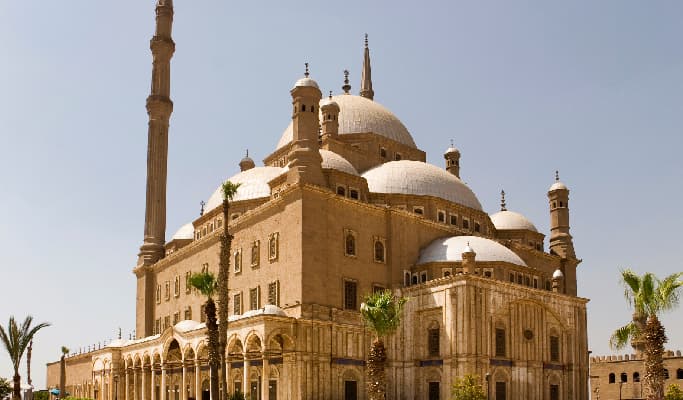
The Mosque of Mohamed Ali does not stand in isolation; it is deeply connected to the broader story of Islamic Cairo. Its position atop the Citadel on the Muqattam Hills gives it commanding views of the city, visually linking it with Cairo’s dense collection of mosques, madrasas, and Islamic monuments below. From its courtyard, visitors can gaze out over a sea of domes and minarets, tracing Cairo’s layered Islamic history.
The Citadel itself, built by Salah al-Din in the 12th century, was the heart of Egypt’s political and military power for nearly 700 years. Successive rulers—including the Ayyubids, Mamluks, and Ottomans—added their own structures, yet it was Muhammad Ali’s alabaster mosque that ultimately became the defining landmark of the complex. In many ways, the mosque symbolizes the transition from medieval Islamic Cairo to a modern vision of the city.
Historically, Islamic Cairo thrived as one of the greatest centers of Islamic civilization. The 14th century marked its golden age, when it became the Islamic world’s new capital, filled with mosques, madrasas, hammams, and bustling markets. During the reign of Sultan al-Nasir Muhammad, Cairo grew to around 500,000 residents, making it the largest city outside China at the time. UNESCO recognized this heritage in 1979 by designating Historic Cairo a World Cultural Heritage site, highlighting its unmatched collection of Islamic architecture.
The journey to the Mosque of Mohamed Ali often begins in Islamic Cairo’s vibrant heart, near Khan el-Khalili bazaar and Al-Muizz Street, where visitors pass landmarks such as the Al-Azhar Mosque before ascending to the Citadel. This physical route mirrors a symbolic one, moving through centuries of history and styles before reaching the Ottoman jewel that crowns the skyline. The mosque thus stands as both a continuation and a transformation of Cairo’s Islamic heritage, linking Egypt’s past, present, and future.
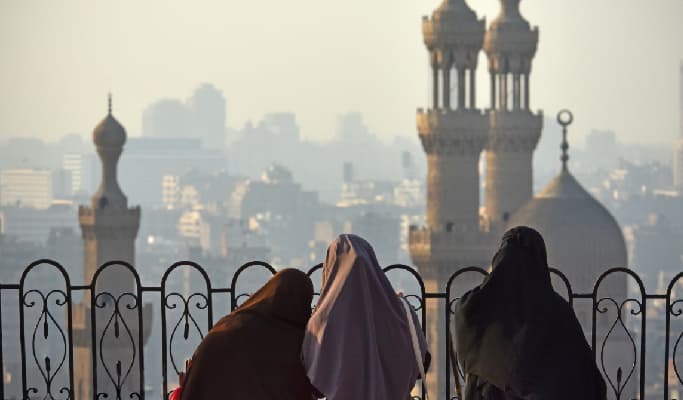
Visiting the Mosque of Mohamed Ali is an unforgettable experience, but a little preparation ensures a smoother and more respectful trip. The mosque is open daily from around 8:00 AM to 5:00 PM, though some sources note that entry may start at 9:00 AM. Non-Muslim visitors can access the main prayer hall during specific hours: typically 9:00–11:00 AM and 1:00–4:00 PM. To enter, you need a ticket for the Citadel complex, which costs between 180–550 EGP for adults (about $6–12 USD), while students with valid ID pay 90–275 EGP.
Guided tours are widely available inside the Citadel. Knowledgeable local guides can explain the mosque’s history, symbolism, and unique features, often including transportation to and from the site. Accessibility is fairly good, with wheelchair access provided, though some areas remain uneven. Vendors near the entrance sell refreshments and souvenirs, but prices are higher than elsewhere, so it is advisable to bring your own water, especially in the summer heat.
As a functioning place of worship, visitors must observe cultural norms. Modest clothing is required: men and women must cover their shoulders and knees, and women should also wear a headscarf. Everyone must remove their shoes before entering the prayer hall, so wearing socks is recommended for comfort. Photography is generally allowed, but flash should be avoided during prayer times, and maintaining a quiet and respectful attitude is essential.
With these considerations in mind, your visit will not only be smooth but also deeply rewarding. Standing inside the mosque, gazing up at its soaring domes and out across Islamic Cairo, you will truly appreciate why this monument is regarded as one of Egypt’s most remarkable treasures.
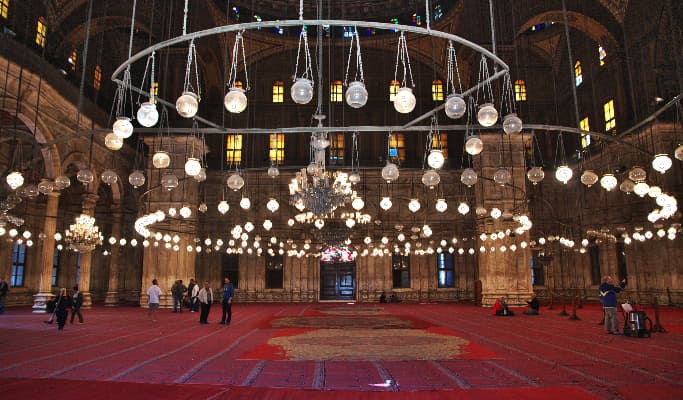
The Mosque of Mohamed Ali is considered a must-see landmark because it combines history, architecture, culture, and symbolism in one breathtaking location. More than just a mosque, it is a statement of Muhammad Ali Pasha’s vision for Egypt and a representation of the country’s transition into modernity. Its Ottoman Baroque style deliberately broke away from Cairo’s medieval Mamluk tradition, aligning the city with the grandeur of Istanbul while introducing new artistic influences.
Architecturally, it is unmatched: alabaster-clad walls, twin 84-meter minarets, and an awe-inspiring dome system create a silhouette that dominates the Cairo skyline. Culturally, it is part of Islamic Cairo’s UNESCO-listed heritage, linking the Ottoman era with centuries of earlier Islamic achievements. Practically, its elevated location provides some of the best panoramic views in the city, making it a favorite for photographers and history lovers alike.
For visitors, experiencing the Mosque of Mohamed Ali is about more than admiring a building—it is about understanding Egypt’s layered history and its place in the Islamic world. Whether you are planning your first trip to Egypt or seeking a deeper connection with Cairo’s past, this mosque is an essential stop on your journey.
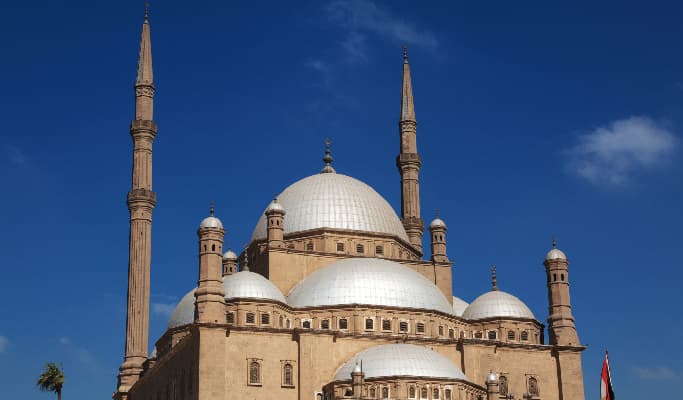
The Mosque of Muhammad Ali showcases Ottoman Baroque architecture, a style that was revolutionary for Cairo at the time. It adopts a layout similar to famous mosques in Istanbul, featuring large domes, towering minarets, and walls encased in alabaster, creating a striking contrast to traditional Egyptian Islamic architecture.
The mosque holds great historical and cultural importance as it symbolizes Egypt's transition into modernity in the 19th century. Built between 1830 and 1848, it represents Muhammad Ali Pasha's vision for a new Egypt and serves as a testament to his efforts to establish the country as a semi-independent state with its own identity.
Construction of the Mosque of Muhammad Ali took approximately 18 years, beginning in 1830 and continuing until Muhammad Ali's death in 1848. The project was overseen by architect Yusuf Boşnak, who was tasked with creating a mosque reminiscent of Istanbul's grand Ottoman structures.
The mosque is renowned for its use of alabaster in its construction, earning it the nickname "Alabaster Mosque." It boasts a central dome 52 meters high, surrounded by four semi-domes, and features twin minarets reaching 84 meters - the tallest in Egypt. The interior is adorned with intricate decorations and houses Muhammad Ali's tomb.
Visitors should be aware of the dress code, which requires modest attire covering shoulders and knees, with women expected to cover their hair. The mosque is open daily, but non-Muslim visitors have specific hours for accessing the main prayer hall. It's advisable to bring socks as shoes must be removed upon entering, and visitors should maintain a respectful demeanor throughout their visit.